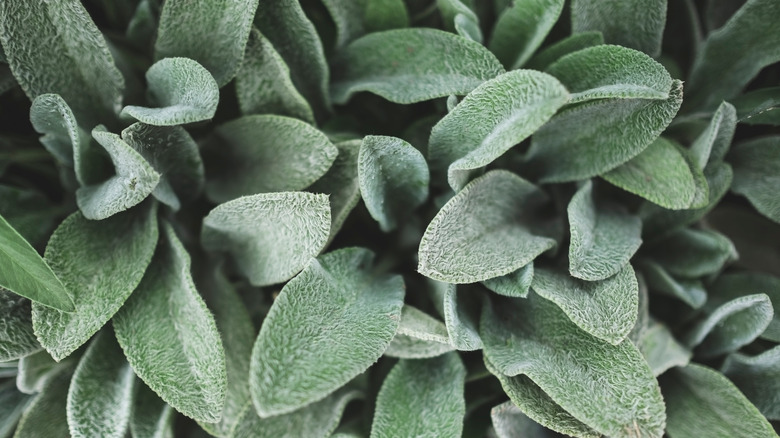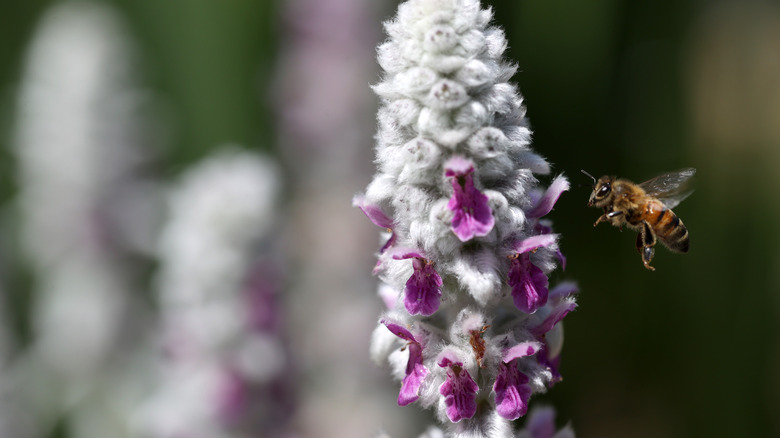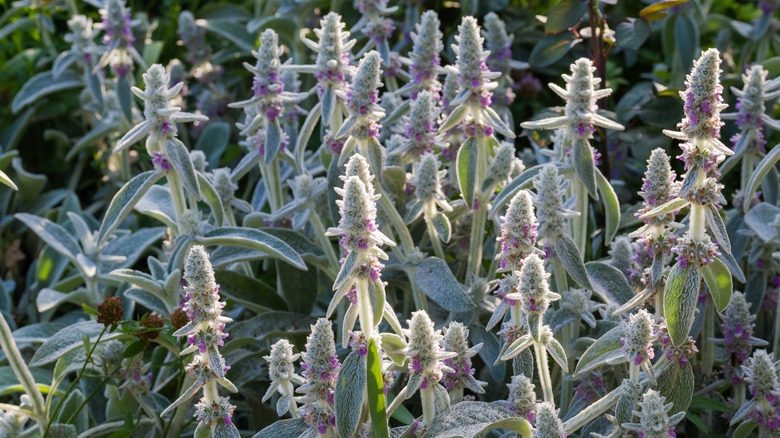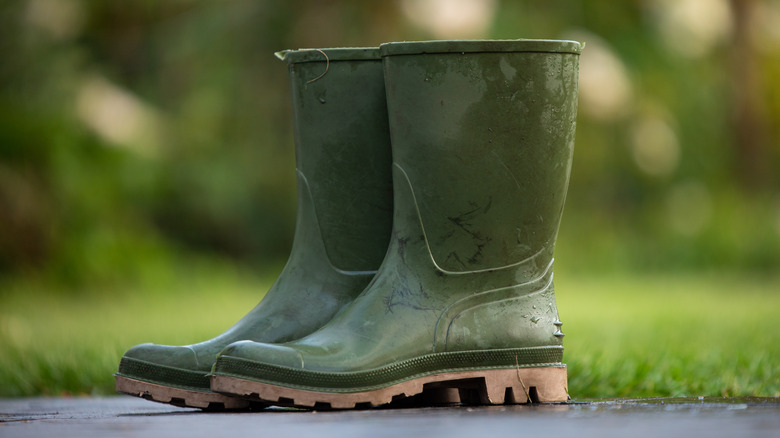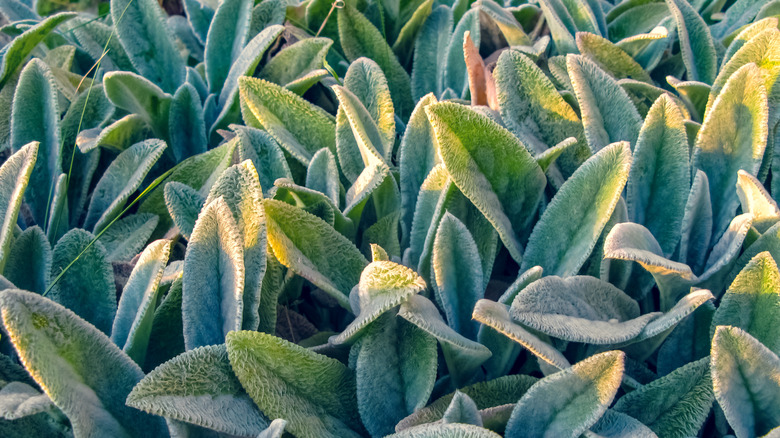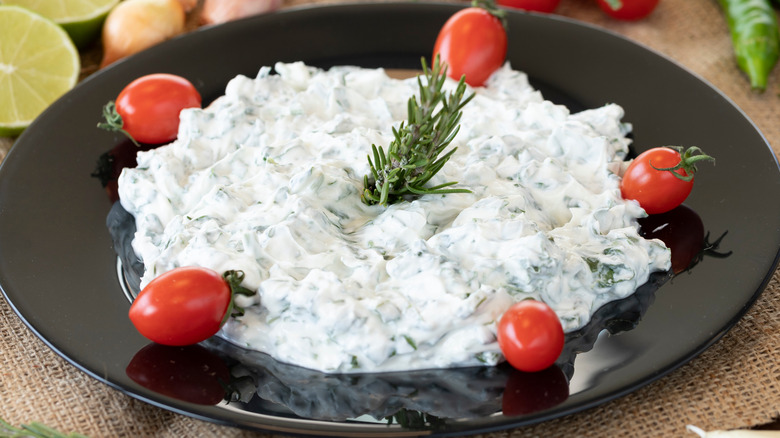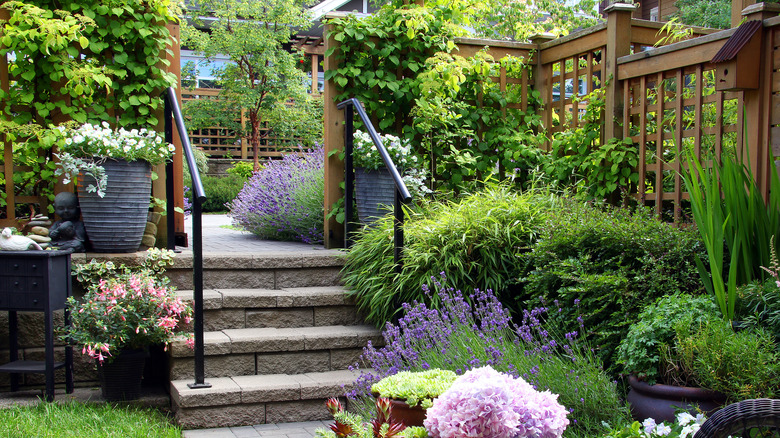How To Successfully Grow A Lamb's Ear Plant
If the sweet appearance of lamb's ear (Stachys byzantina) with its floppy, frost-kissed leaves hasn't won it a space in your garden, perhaps its simple care and prolific ground coverage will. A member of the mint family, this perennial has a low spreading profile punctuated in the summer with fantastic blooming spikes, which drive the bees to a frenzy and attract hummingbirds and butterflies, as per Bob Vila. What a charmer!
Originally native to the Middle East, Gardening Know How explains that lamb's ear prefers full sun to partial shade and well-draining soil, even tolerating drought-like conditions; perfect for the gardener who, ahem ... is easily distracted from plant-parent responsibilities. With a USDA hardiness zone classification of 4-8, it can grow successfully over the vast majority of the continental US. Per HGTV, the fuzziness of the foliage, while one of its most endearing characteristics, is unappetizing to deer and rabbits. That's no small win for the beautification of suburban and rural yards!
Once established, you'll need to prune regularly in the spring and routinely deadhead the spent flowers to keep this self-seeder from spreading. Or let it grow, and then divide the bounty of sage-green lamb's ear to other parts of your garden.
How to use lamb's ear in garden
The gentle tactile nature of lamb's ear makes it a prized plant to grow in a children's garden, per The Spruce. Appealing to their senses, it also invites curiosity and closer observation. Lamb's ear, also called wooly hedge-nettle (Tell us that doesn't sound like a character in a children's book!), is easy to grow and contains no thorns or sap to zap the young gardener's interest.
Lamb's ear can offer a textural and color counterpoint to shiny, darker foliage. Additionally, a fast-growing root system makes lamb's ear an excellent ground cover. Or, per The Gardening Cook, put this low-profile perennial at the front of a garden or border where its interesting foliage can be highlighted, and sunlight won't be obstructed by taller specimens.
The Spruce suggests creating a moon garden with lamb's ear — the plant's silver touches will reflect the moonlight at night, creating a delightful visual effect in your garden. According to Better Homes & Gardens, the pretty blooms will also become the seeds that spread and self-sow; you may need to decide if your goal is to create a neat, contained ground cover or a pollinator's paradise. In the latter case, feel free to let lamb's ear grow as it may without cutting it back.
How to grow lamb's ear
Lamb's ear requires minimal effort to grow in well-drained soil and partial to full sun — not surprising given its origins in hot and arid climates. Some dappled shade during peak temperatures will prevent sun-burn damage. Conversely, high humidity and waterlogged dirt are the worst conditions for growing lamb's ear; The Spruce recommends adding organic matter to increase drainage and aeration if these are concerns. This plant also prefers a neutral pH and unfertilized soil.
Plant nursery pots in early spring, about 2 feet apart to allow for spread, or a bit closer for immediate fullness, dividing them in the future if they overcrowd. (Not all varieties of lamb's ear flower, so check first to ensure you've chosen your desired cultivar.) Water them adequately as they become established. Plants can also be grown from seed — New Life on a Homestead recommends using a seed-starting mix kept well-watered and out of full sun until sprouts are visible. Then place them where they'll receive no fewer than six hours of sunlight per day.
How to care for lamb's ear
It's a good habit to remove brown and decaying leaves during the growing season — this prevents the spread of diseases, such as fungal leaf spot and powdery mildew, and makes the area less hospitable to woodlice. Further, you'll want to discourage conditions amenable to rot: Occasionally prune to thin overcrowded plants, counter humidity and excessively moist soil with a light layer of mulch, and avoid overhead sprinklers. HGTV explains that lamb's ear leaves will most likely die off in the cold of winter; a thorough, gentle raking in early spring will suffice to remove plant detritus and prepare for emerging leaves.
Per The Spruce, many gardeners deadhead the bracts, or flower stalks, before they go to seed. This concentrates the plant's energy toward maintenance of the wooly foliage and helps to control spreading through self-seeding. Keep in mind that the blooming flowers attract numerous pollinators, which has benefits that carry beyond the garden.
Lamb's ear can be easily divided once it becomes too dense or unruly. SFGate recommends dividing every few years before new growth has begun. Pull the plants in clumps along with their roots, which spread outward copiously but shallowly. Transplant them to another location at a distance of 1 to 2 feet apart.
Varieties of lamb's ear
Lamb's ear (Stachys byzantina) is from the Lamiaceae family; it's a distant relation to mint, but without the same aggressive invasiveness. Leaves have a wrinkled texture and fine, velvety coating of hairs on both sides that retain moisture. They can range in color from silver to grey-green and blue-green. If of a flowering variety, blooms come in dark pink, white, red, and plum, clustering around tall flower spikes in late spring and summer. Whichever variety is chosen, the gardener will be rewarded with a nearly carefree plant, quick to cover empty ground and soften the landscape.
There are a few cultivars commonly available in nurseries, as per Love to Know.
- 'Silver Carpet' and 'Cotton Boll' are both non-flowering and lauded for their soft, silvery foliage.
- 'Big Ears,' aka Helen von Stein, is known for its excessively large leaves and ability to tolerate high humidity.
- 'Primrose Heron' stands out with variegated yellow and green leaves that grow in the spring.
- 'Silky Fleece' has frosty white foliage and purple flowers, as per the Missouri Botanical Garden.
Is lamb's ear toxic?
Lamb's ear is not toxic and is actually edible, per New Life on a Homestead. Choose young, unblemished leaves; they can be consumed raw, lightly steamed, or stir-fried. Fresh, it's an unexpected salad component with a flavor redolent of fruit — Plant Care Today describes it as an herb tasting of apple and pineapple.
With many purported medicinal uses, Farm Homestead explains that lamb's ear was relied on in the past for its antiseptic, antibacterial, and sedative qualities. Dried leaves were steeped to make tea for colds, oral infections, and fever. Topically, macerated leaves were used as a poultice for insect bites and bee stings, and whole leaves were applied like bandages to wounds and bruises. A natural astringent found in the leaves aids in blood clotting while anti-inflammatory properties encourage healing.
Plant-based dyes are gaining in popularity among eco-conscious and slow-fashion brands. The resulting natural colors are subtle and luminous. Boiled lamb's ear leaves and flower spikes, combined with a mordant, or color-fixative, create a muted vanilla and purple dye, respectively.
How to repot lamb's ear
Because of lamb's ear's proclivity to spread, it is not the best candidate for restricting to small containers. That being said, it does work well in a large pot when companion planted with other species requiring similar sun and water conditions. It's a perfect filler for the basic rule of container gardens taught by Better Homes & Gardens – that to create a balanced, lush, and eye-catching combination, each needs a filler, spiller, and thriller. Since it is edible, lamb's ear can also be a component in a mixed herb container — while less visually attractive perhaps, it's a summer salad or sauce waiting to happen.
Lamb's ear likes well-drained soil, so consider mixing in peat moss, which HGTV explains is an inexpensive way to loosen clay and sandy soils. Remember that it typically doesn't need to be fertilized. Choose a pot with a proper drainage system, and in a material that helps to pull out excess moisture, like terracotta. Get Busy Gardening suggests repotting in the morning or evening to prevent transplant shock. Water thoroughly after repotting, but not too much.
